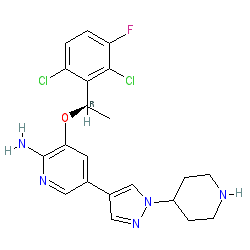GtoPdb is requesting financial support from commercial users. Please see our sustainability page for more information.
|
Synonyms: (R)-crizotinib | PF 2341066 | PF-02341066 | PF-2341066 | PF2341066 | Xalkori®
crizotinib is an approved drug (FDA (2011), EMA (2012))
Compound class:
Synthetic organic
Comment: Critzotinib is a Type-1 kinase inhibitor and was first approved by the FDA in 2011. It inhibits ALK, cMET and ROS1 receptor tyrosine kinases. Critzotinib is a chiral molecule that exploits the three-dimensional space of the ATP pocket to achieve optimal potency and selectivity [6]. The R-enantiomer as shown here exhibits better potency than the either the racemate or S-isomer and the approved drug should contain only the R-enantiomer.
Pfizer developed the 3rd generation ALK inhibitor lorlatinib as a follow-up to critzotinib, and this new drug has been reported to outperfom its predecessor in lung cancer. Ligand Activity Visualisation ChartsThese are box plot that provide a unique visualisation, summarising all the activity data for a ligand taken from ChEMBL and GtoPdb across multiple targets and species. Click on a plot to see the median, interquartile range, low and high data points. A value of zero indicates that no data are available. A separate chart is created for each target, and where possible the algorithm tries to merge ChEMBL and GtoPdb targets by matching them on name and UniProt accession, for each available species. However, please note that inconsistency in naming of targets may lead to data for the same target being reported across multiple charts. ✖ |
|
|||||||||||||||||||||||||||||||||||
| No information available. |
Mechanism Of Action and Pharmacodynamic Effects  |
| Critzotinib inhibits receptor tyrosine kinases, including anaplastic lymphoma kinase (ALK, including its oncogenic variants i.e. ALK fusion events and selected ALK mutations), recepteur d'origine nantais (RON) and hepatocyte growth factor receptor (HGFR, c-Met) [9]. Crizotinib demonstrates dose-dependent anti-tumour efficacy, including marked cytoreductive anti-tumour activity, in mice bearing tumour xenografts that express ALK fusion proteins, which correlates with pharmacodynamic inhibition of phosphorylation of ALK fusion proteins (including EML4-ALK and NPM-ALK) in tumours in vivo. Crizotinib is currently thought to exert its effects through modulation of the growth, migration, and invasion of malignant cells and/or by inhibiting angiogenesis in malignant tumours. . |
Pharmacokinetics  |
| Absorption/Distribution |
| Peak circulating concentrations are achieved between 4 to 6 hours after oral dosing. Absolute bioavailability ranges between 32% and 66%. Crizotinib may be taken with or without food. A high volume of distribution (1772 L) following intravenous administration of a 50 mg dose indicates extensive distribution from the plasma into tissues. Binding of crizotinib to human plasma proteins in vitro is 91% and is not related to drug concentration. In vitro studies suggest that crizotinib is a substrate for P-glycoprotein (P-gp), therefore crizotinib may have the potential to increase curculating concentrations of coadministered medicinal products that are also substrates of P-gp. |
| Biotransformation/Metabolism |
| Predominantly metabolized in the liver by CYP3A4 and CYP3A5. Concomitant use of crizotinib with strong CYP3A4 inhibitors or inducers should be avoided. Prescribers should also be aware of a potential pharmacokinetic herb-drug interaction in patients who self-administer complementary/alternative medicines that contain ginger, as evidence suggests this may lead to the accumulation of crizotinib and subsequently to crizotinib-induced hepatotoxicity [5]. |
| Elimination |
| Following the administration of a single 250 mg radiolabeled crizotinib dose to healthy subjects, 63% (53% unchanged) was recovered in feces and 22% (2.3% unchanged) in urine. |
| Population pharmacokinetics |
| Cmax and AUC are higher in Asian compared to non-Asian patients. |
| Organ function impairment |
| Hepatic impairment: Results from clinical studies excluded patients with ALT or AST >2.5 x ULN or, if due to underlying malignancy, >5.0 x ULN or with total bilirubin >1.5 x ULN from crizotinib treatment. Renal impairment: No starting dose adjustment is recommended for patients with mild and moderate renal impairment. No formal dosing recommendation can be made regarding patients with severe and end-stage renal disease as no data are available. Cardiac electrophysiology: A pharmacokinetic/pharmacodynamic analysis of all patients who received crizotinib 250 mg twice daily suggested a relationship between crizotinib plasma concentration and QTc as measured by automated machine-read evaluation of ECG. |
External links  |
|
For extended ADME data see the following: Electronic Medicines Compendium (eMC) Drugs.com European Medicines Agency (EMA) |









